2000 AD Covers Uncovered – INJ Culbard’s Inter-sect-ions for Prog 2284 – ‘The Eye of Vovek is everywhere.’
1st June 2022
Every week, 2000 AD brings you the galaxy’s greatest artwork and 2000 AD Covers Uncovered takes you behind-the-scenes with the headline artists responsible for our top cover art – join bloggers Richard Bruton and Pete Wells as they uncover the greatest covers from 2000 AD!
This week we have INJ Culbard on the cover of 2000 AD Prog 2284 with another one of his striking Brink covers – out wherever you get your Thrill Power on 1 June.
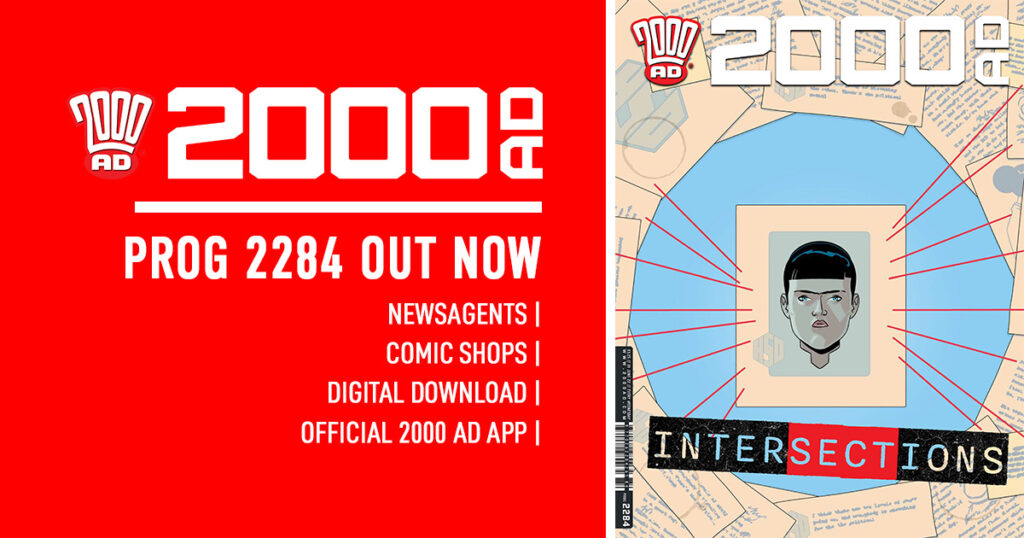
But it’s a very different sort of Covers Uncovered this week, with Ian talking us through the whole process of making the cover but without the usual process images.
As you can see, it’s one of those fabulous covers that’s so deceptively simple, and that’s what makes it so very striking and one that you just can’t miss on the shelves this week – all thanks to Ian’s artwork and stylings.
As he’ll tell you in just a moment, the cover was a brief from Tharg riffing on the imagery in the latest episode of Brink: Mercury Retrograde – and that’s why there aren’t really any cover process images, all of the preliminary work had really already been done inside the episode and Ian just took inspiration from that.
As you’ll see through the panels we’ve included here, we’re at the stage in the brilliant Mercury Retrograde where investigative journalist Nolan Maslow breaks down what he’s uncovered so far, all about the Unions, the links to the Sects, HabSec, and the way that the Brink itself is psychologically damaging.
As you’d expect, it’s not exactly left Mas in a good place either…
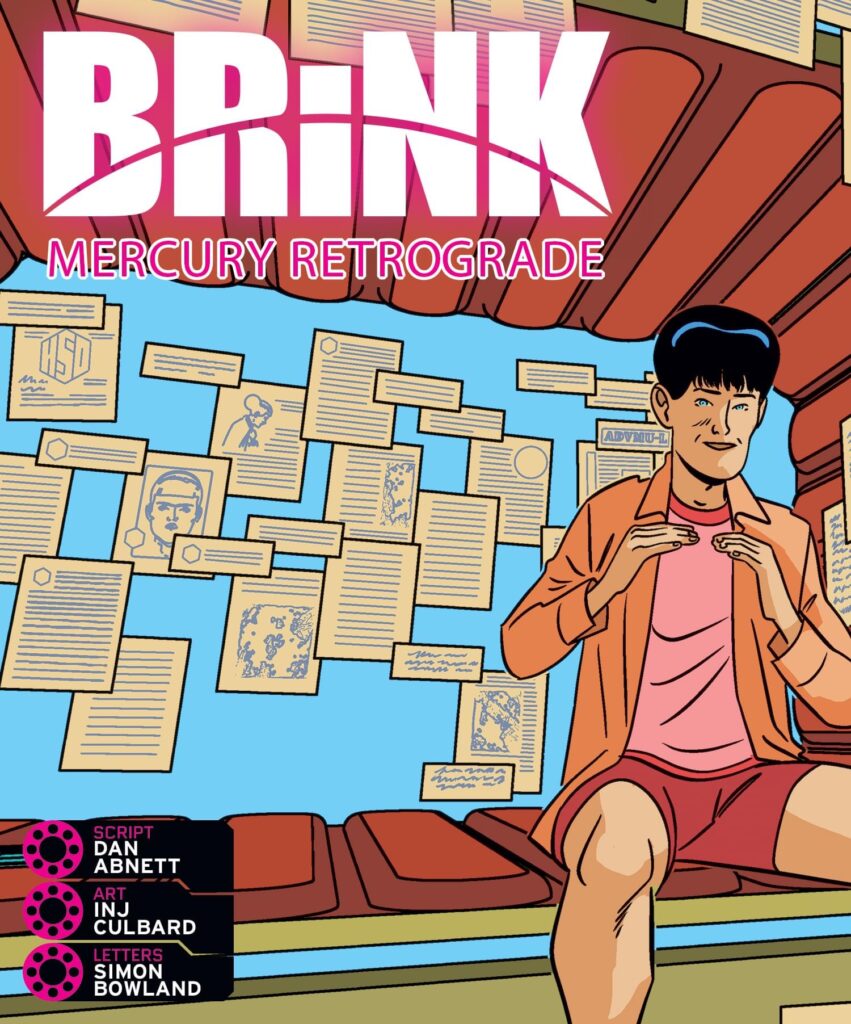
Ian, you’re on the cover of Prog 2284 with a Brink cover that hints very much at bringing everything in Mercury Retrograde at least a little bit together.
In this latest installment, we have investigative journalist Nolan Maslow presenting his findings on what he’s uncovered so far, including what he’s calling ‘Brink Anxiety’. And of course, all of this ties right back into the very first Brink storyline as Mas’ investigations have been spurred on by the death of Brinkman and the Union/Sect connection that sent Bridget Kurtis off on her own path. So far, Kurtis and Maslow haven’t been in direct contact, but that may well change I suppose.
Now, as for the cover, it’s another one that has that circular symbolism, something that’s run through every Brink cover except the very first one. So, what’s the deal with the circular motif running through your Brink covers?
INJ CULBARD: Don’t you know? The Eye of Vovek is everywhere.
Oh yes, the Eye gets everywhere… and it certainly implies that Kurtis is central to everything here, even though we haven’t seen practically anything of her yet.
As for the Inter’sect’ions cover tagline – was that yours or did Tharg have a hand in it?
INJC: That was Tharg.
As far as putting the cover together, where does the initial idea come from – presumably Tharg gets in touch with the request for a cover and you give him some ideas riffing on a theme?
INJC: Again Tharg. It was a brief. I tend to stick exactly (or as close to) brief, so I don’t know that there was even that much of a rough stage for this given as it was drawing on imagery from the interior art, and it was so straightforward.
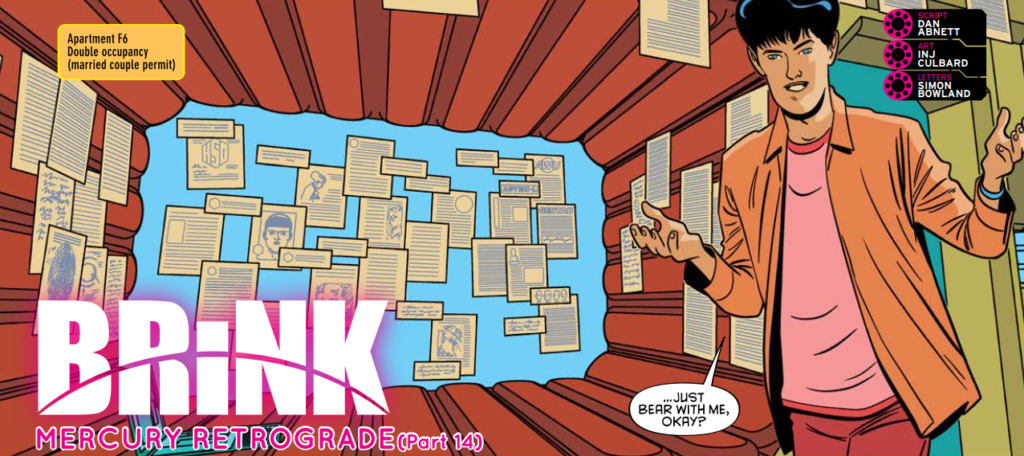
Do you tend to fix the idea quickly for the cover and simply submit that to Tharg or, like PJ Holden and others, give Tharg multiple choices for the possible cover layout?
INJC: Occasionally. I did suggest the pages were on the floor surrounded by stuff like a shoe and Maz’s writepad and a coffee cup, I think I was doing this because I was a little nervous of the image being so simple. Classic avoidance.
I find that the simpler something appears the harder it is in execution because you’ve not got very little to work with — not as much to distract the reader with. So I did try to suggest it was on the floor so I could introduce all these other elements, but Tharg was keen to have that blue wall there. So I stuck to the brief.
The bottom line here is, I trust in Tharg.
So say we all Ian, so say we all.
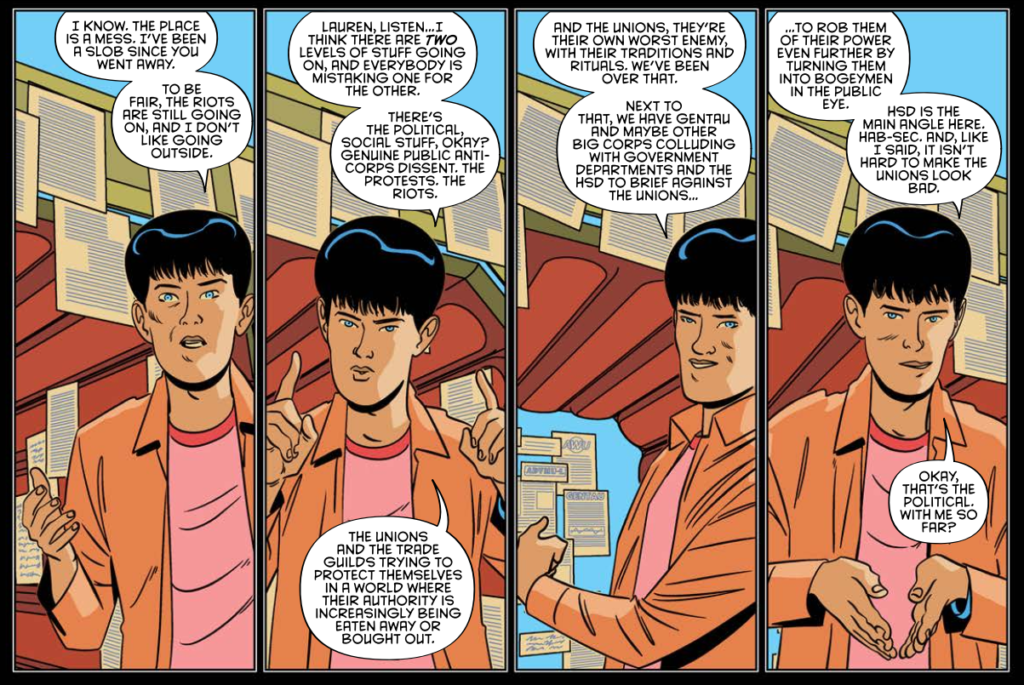
You’re in the position now where you’ve established a pattern with these covers, so I’d imagine most of the time the covers get approved with little trouble?
INJC: Yes. I mean, sometimes there’s a little bit of back and forth with really crude sketches to suggest alternatives, I never work anything up beyond a thumbnail I couldn’t sketch in a matter of seconds in response to an email, it’s always very rapid-fire like that if it does come to that.
I mean, believe it or not, the thing that took the longest in our discussions on this particular cover was how many red lines there should be and where they should be pointing, I did a couple of variations of that, but very quick, in document notations over the jpegs I’d sent. The decision-making is over in a matter of minutes.
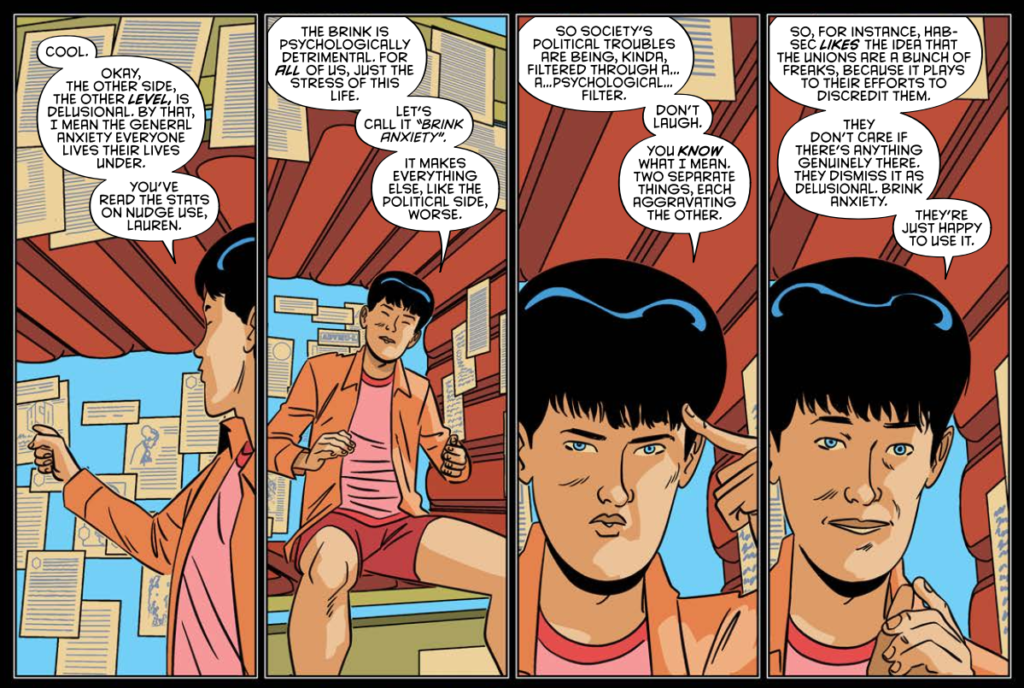
Okay then, after the initial sketch gets approval, where does the art go then? I seem to remember you saying that you’re working completely digitally now? What’s the process involved in putting it all together – if it is digital I’m assuming you don’t go the typical traditional route of pencils to inks to colour? And what software are you using to make the art now?
INJC: I’ve always worked digital ever since I started out. I work in Clip Studio and that’s a program specifically for comics. Something I hated doing before was marking up panels and gutters… this does all that calculation for you and very quickly, so that’s cool. No more smudging lines with a plastic ruler and then having to use correction paint on it. But otherwise it’s drawing as I would on paper, just on a screen instead. Same thing really. Takes a little getting used to but you do get used to it.
I work on a desktop and on an iPad Pro (which is awesome because I can sit anywhere and work on that… I can get away from my desk) and I love drawing with the Apple Pencil so much (it’s perfect weight etc) that I draw all of the comic in Clips Studio for the iPad. You can calibrate how the pen reacts to pressure (if you’ve ever worked with dip pen nibs, it’s like adjusting those for flow and pressure sort of…). I tend to think it’s pretty crude the way I do it because I just draw. I’m sure there are lots of bells and whistles and fancy tricks it can do but my demands of it have always been quite simple. Draw.
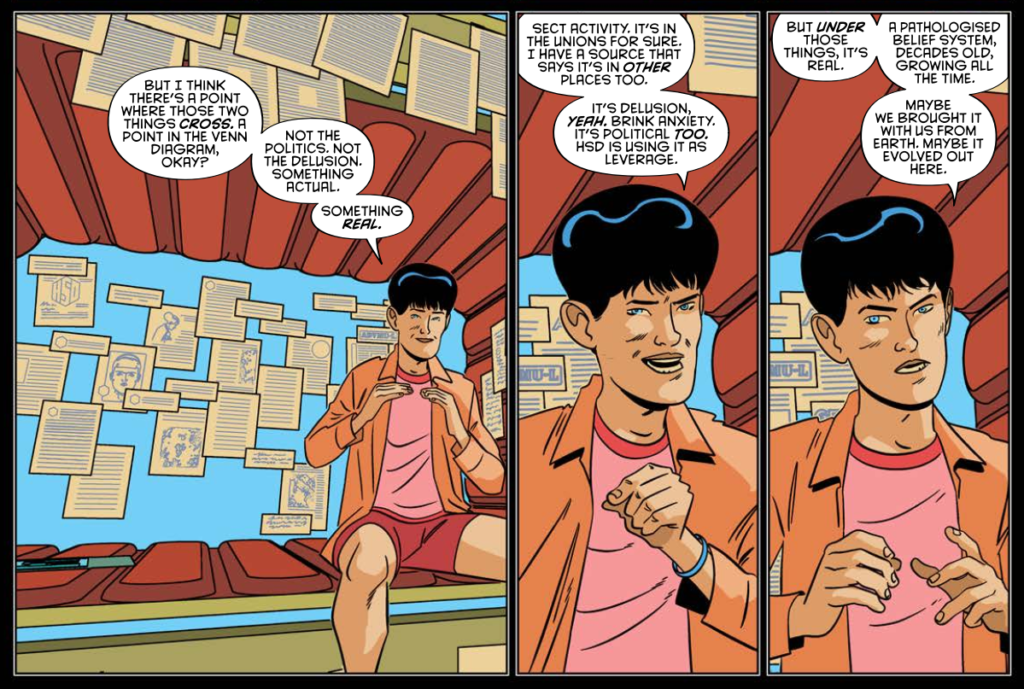
INJC: Whether it’s a graphics tablet stylus or a lead pencil or an inking brush, you still need the artist to push that thing around. Digital tools are just that. Tools. Like a pencil or a ruler. The art is the artist. The art is to the art what the violinist is to music… the violin is a tool of expression. When I’m done with black and white I produce flats, which is a layer under the art with color isolated areas. When that’s done I then export that to photoshop and I color there. That process involves trapping the line art – which is a technique that ensures that the color beneath the line art has enough room that if there’s a misprint (black line art printing over a color page) and it goes off register (they sometimes do by a pixel or so) it doesn’t show because the color art is buffered together as much as possible under the line art. And I work with a zero K palette (CMYK… no black in the color whatsoever) so it doesn’t muddy the art… and that’s pretty much it.
Then it goes off for approval and I’m done. Next batch of pages.
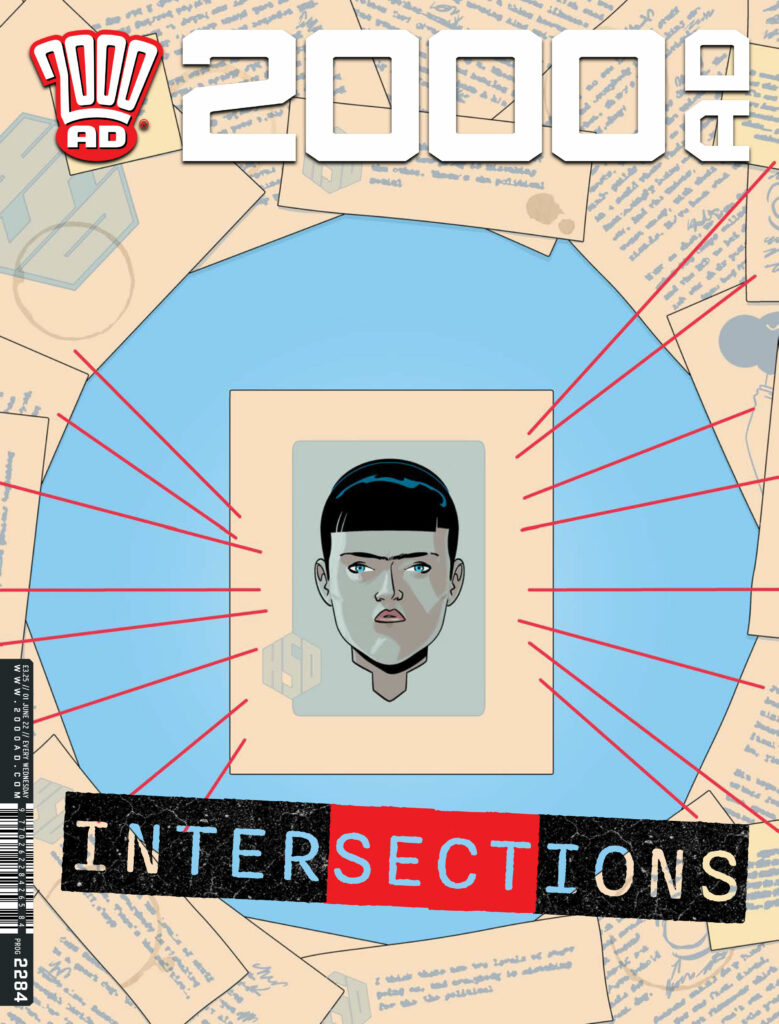
Don’t you love it when the artists go technical? But no matter how much we have the veil lifted and they let us know how they do what they do, there’s still that sense of it all coming together as if by some arcane magic.
But thanks to Ian for sending over the details of all that he does. You can find 2000 AD Prog 2284 and the latest episode of Brink: Mercury Retrograde wherever you pick up your weekly dose of Thrill Power, including the 2000 AD web shop from 1 June.
The entire series of Brink to date, written by Dan Abnett and drawn by INJ Culbard, is available in four books so far – one of the most incredible pieces of sci-fi procedural work you’ll ever read. It’s never too late to discover just how excellent this series is – you can buy them here – Brink Book 1, Brink Book 2, Brink Book 3, Brink Book 4.
For more of Ian’s covers, have a read of his previous Covers Uncovered, from Prog 1978, Prog 2039, Prog 2272, Prog 2278.
